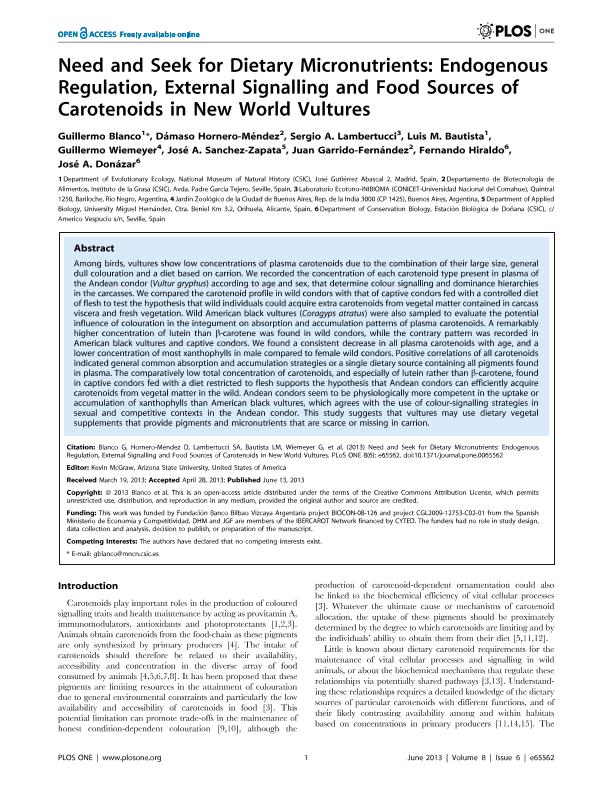Mostrar el registro sencillo del ítem
dc.contributor.author
Blanco, Guillermo
dc.contributor.author
Hornero Méndez, Dámaso
dc.contributor.author
Lambertucci, Sergio Agustin

dc.contributor.author
Bautista, Luis M.
dc.contributor.author
Wiemeyer, Guillermo

dc.contributor.author
Sanchez Zapata, José A.
dc.contributor.author
Garrido Fernández, Juan
dc.contributor.author
Hiraldo, Fernando

dc.contributor.author
Donázar, José A.
dc.date.available
2015-05-19T13:16:28Z
dc.date.issued
2013-06-13
dc.identifier.citation
Blanco, Guillermo; Hornero Méndez, Dámaso; Lambertucci, Sergio Agustin; Bautista, Luis M.; Wiemeyer, Guillermo; et al.; Need and Seek for Dietary Micronutrients: Endogenous Regulation, External Signalling and Food Sources of Carotenoids in New World Vultures; Public Library of Science; Plos One; 8; 6; 13-6-2013; 1-11; e65562
dc.identifier.issn
1932-6203
dc.identifier.uri
http://hdl.handle.net/11336/492
dc.description.abstract
Among birds, vultures show low concentrations of plasma carotenoids due to the combination of their large size, general dull colouration and a diet based on carrion. We recorded the concentration of each carotenoid type present in plasma of the Andean condor (Vultur gryphus) according to age and sex, that determine colour signalling and dominance hierarchies in the carcasses. We compared the carotenoid profile in wild condors with that of captive condors fed with a controlled diet of flesh to test the hypothesis that wild individuals could acquire extra carotenoids from vegetal matter contained in carcass viscera and fresh vegetation. Wild American black vultures (Coragyps atratus) were also sampled to evaluate the potential influence of colouration in the integument on absorption and accumulation patterns of plasma carotenoids. A remarkably higher concentration of lutein than β-carotene was found in wild condors, while the contrary pattern was recorded in American black vultures and captive condors. We found a consistent decrease in all plasma carotenoids with age, and a lower concentration of most xanthophylls in male compared to female wild condors. Positive correlations of all carotenoids indicated general common absorption and accumulation strategies or a single dietary source containing all pigments found in plasma. The comparatively low total concentration of carotenoids, and especially of lutein rather than β-carotene, found in captive condors fed with a diet restricted to flesh supports the hypothesis that Andean condors can efficiently acquire carotenoids from vegetal matter in the wild. Andean condors seem to be physiologically more competent in the uptake or accumulation of xanthophylls than American black vultures, which agrees with the use of colour-signalling strategies in sexual and competitive contexts in the Andean condor. This study suggests that vultures may use dietary vegetal supplements that provide pigments and micronutrients that are scarce or missing in carrion.
dc.format
application/pdf
dc.language.iso
eng
dc.publisher
Public Library of Science

dc.rights
info:eu-repo/semantics/openAccess
dc.rights.uri
https://creativecommons.org/licenses/by-nc-sa/2.5/ar/
dc.subject
Cathartidae
dc.subject
Carotenoids
dc.subject
Colouration
dc.subject
Signals
dc.subject.classification
Otras Ciencias Biológicas

dc.subject.classification
Ciencias Biológicas

dc.subject.classification
CIENCIAS NATURALES Y EXACTAS

dc.title
Need and Seek for Dietary Micronutrients: Endogenous Regulation, External Signalling and Food Sources of Carotenoids in New World Vultures
dc.type
info:eu-repo/semantics/publishedVersion
dc.type
info:ar-repo/semantics/artículo
dc.type
info:eu-repo/semantics/article
dc.date.updated
2016-03-30 10:35:44.97925-03
dc.journal.volume
8
dc.journal.number
6
dc.journal.pagination
1-11; e65562
dc.journal.pais
Estados Unidos

dc.journal.ciudad
San Francisco
dc.description.fil
Fil: Blanco, Guillermo. Consejo Superior de Investigaciones Cientificas. Museo Nacional de Ciencias Naturales; España
dc.description.fil
Fil: Hornero Méndez, Dámaso. Consejo Superior de Investigaciones Cientificas. Instituto de la Grasa; España
dc.description.fil
Fil: Lambertucci, Sergio Agustin. Consejo Nacional de Investigaciones Científicas y Técnicas. Centro Científico Tecnológico Conicet - Patagonia Norte. Instituto de Investigaciones en Biodiversidad y Medioambiente. Universidad Nacional del Comahue. Centro Regional Universidad Bariloche. Instituto de Investigaciones en Biodiversidad y Medioambiente; Argentina
dc.description.fil
Fil: Bautista, Luis M.. Consejo Superior de Investigaciones Cientificas. Museo Nacional de Ciencias Naturales; España
dc.description.fil
Fil: Wiemeyer, Guillermo. Ciudad Autónoma de Buenos Aires. Jardín Zoológico; Argentina
dc.description.fil
Fil: Sanchez Zapata, José A.. Universidad de Miguel Hernández; España
dc.description.fil
Fil: Garrido Fernández, Juan. Consejo Superior de Investigaciones Cientificas. Instituto de la Grasa; España
dc.description.fil
Fil: Hiraldo, Fernando. Consejo Superior de Investigaciones Científicas. Estación Biológica de Doñana; España
dc.description.fil
Fil: Donázar, José A.. Consejo Superior de Investigaciones Científicas. Estación Biológica de Doñana; España
dc.journal.title
Plos One

dc.relation.alternativeid
info:eu-repo/semantics/altIdentifier/doi/http://dx.doi.org/10.1371/journal.pone.0065562
dc.relation.alternativeid
info:eu-repo/semantics/altIdentifier/url/https://journals.plos.org/plosone/article?id=10.1371/journal.pone.0065562
Archivos asociados
